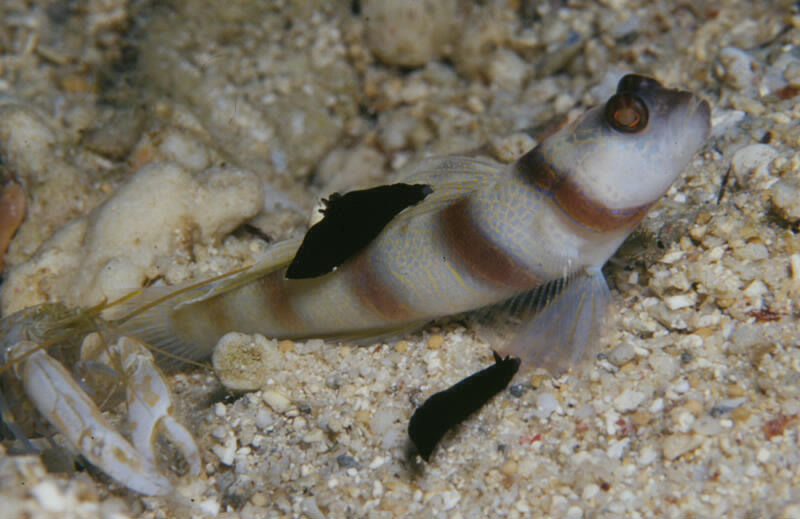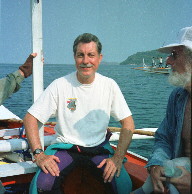 |
Gymnodoris nigricolor
Photo courtesy of Mary Jane Adams
Gymnodoris nigricolor Baba, 1960
In the opisthobranch kingdom we have algae eaters, sponge eaters, hydroids eaters, soft coral eaters, jelly fish eaters, egg eaters and now a fish eater. Gymnodoris nigricolor has really tipped the food chain upside down, a lowly sea slug feeding on a far more advanced species, a vertebrate, a fish.
Mary Jane has captured on film one of the most incredible opisthobranch relationships known today. Previously known only from Okinawa, where Okinawan slug site master, Bob Bolland has documented this odd couple numerous times, providing what little information we have about this species. Mary Jane's observation now expands the range to the Solomons. Mary Jane took the photo above at Wickum Island, Morovo Lagoon, Solomon Islands, Nov. 16, 2001. Her depth was about 13 meters. She found this combo of two slugs, two snapping shrimp and one goby living in a steep sand slope on the lagoon side of a small island. The sand was clean and white and extended for about 300 meters between coral reefs. There are several species of shrimp gobies in this area, with the species shown here which she has identified as Amblyeleotris steinitzi. Mary Jane shared the following with me:
"...I noticed the slug on the dorsal fin from three meters away. It was flopping from side to side as the goby waved it's dorsal fin. After shooting some pictures, I noticed the second slug on the right pelvic fin. They seem to be very firmly attached to the distal edge of the fins. The goby's behavior seemed normal and I did not see any evidence of fin damage other than where the slugs were clamped on..."
Her observations of the of the critters ability to hold onto the goby's fin tightly is important. Gobies are fast swimmers, darting to and fro in rapid jerks. Any animal hoping to utilize this fish as a source of food needs to have a strong hold on its host. In this case the nudibranch holds on with a strong pair of jaws. This relationship appears to be parasitic, rather than symbiotic, as the goby derives no observable benefit at all from the dorid nudibranch.
Mary Jane asked me, where do individuals of Gymnodoris nigricolor hang out when not on their host, what do they eat and where do they lay their eggs. All are great questions. I don't believe the dorid has been observed on any substrate other than species of gobies, on which it lives permanently and feeds directly. You might wonder how two individuals reproduce. How do they find each other and get together, riding on the fins of this darting, bucking bronco? This would be interesting to see. Concerning their eggs, Bob Bolland and Bill Rudman show eggs masses laid in the aquarium, but no one has documented where eggs are laid in nature.
Specimens have been observed ranging up to about 8mm in length, and were found at depths to about 29meters. Bob Bolland observations indicate that the species is seasonal at Okinawa, occurring from December-January through June, with no observations July through November.
Observations and photos like these are only way we are going to learn more
about this species and its curious and interesting relationship with its
fishy host. Keep your eyes open.
Danville, Calif
Dec. 2001
Mary Jane as guest at PNG costume party
where the theme was going "native"

Send Mary Jane mail at divepng@yahoo.com |

David W. Behrens
Author:
Pacific Coast Nudibranchs |
